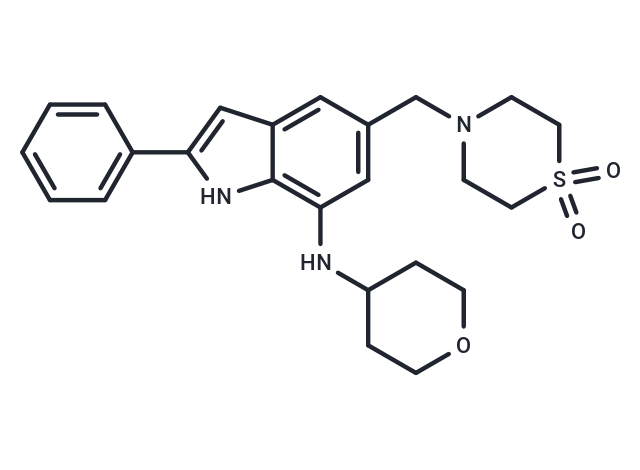Shopping Cart
- Remove All
 Your shopping cart is currently empty
Your shopping cart is currently empty

NecroX-7 (LC-280126) is a potent free radical scavenger and HMGB1 (high-mobility group box 1) inhibitor. It serves as an antidote to acetaminophen toxicity and exerts a protective effect by preventing HMGB1 release in ischemia/reperfusion injury. Additionally, NecroX-7 inhibits HMGB1-induced release of TNF and IL-6 and the expression of TLR-4 and receptor for advanced glycation end products. This compound may be used for graft-versus-host disease (GVHD) research [1].

| Pack Size | Price | Availability | Quantity |
|---|---|---|---|
| 1 mg | $51 | In Stock | |
| 5 mg | $122 | In Stock | |
| 10 mg | $198 | In Stock | |
| 25 mg | Preferential | In Stock | |
| 50 mg | Preferential | In Stock |
| Description | NecroX-7 (LC-280126) is a potent free radical scavenger and HMGB1 (high-mobility group box 1) inhibitor. It serves as an antidote to acetaminophen toxicity and exerts a protective effect by preventing HMGB1 release in ischemia/reperfusion injury. Additionally, NecroX-7 inhibits HMGB1-induced release of TNF and IL-6 and the expression of TLR-4 and receptor for advanced glycation end products. This compound may be used for graft-versus-host disease (GVHD) research [1]. |
| In vitro | NecroX-7, at concentrations ranging from 0 to 40 μM and incubated for 3-4 days, effectively suppresses the activation and proliferation of T cells without inducing apoptosis, as demonstrated in a study [1]. Additionally, this compound significantly reduces high-mobility group box 1 (HMGB1) levels in a dose-dependent manner and inhibits the generation of mitochondria-specific reactive oxygen species (ROS) and reactive nitrogen species in H9C2 cardiac cells and hepatocytes, triggered by tert-butyl hydroperoxide or doxorubicin [1]. Moreover, NecroX-7 has been shown to increase the numbers of regulatory T cells, suggesting its potential role in the modulation of differentiation signals that are independent of HMGB1 effects [1]. In a cell proliferation assay utilizing CD4 T cells across a gradient of 0 to 40 μM concentrations over 3-4 days, a significant decline in splenocyte proliferation was observed, indicating its effectiveness in modulating alloreactive T cell responses in a dose-dependant manner [1]. |
| In vivo | NecroX-7 (0-0.3 mg/kg, IV, once injection at 2-day intervals for 2 weeks) significantly reduces graft-versus-host disease (GVHD)-related mortality and tissue damage by regulating regulatory T/Th1 cells, lowering systemic High Mobility Group Box 1 (HMGB1) levels, and mitigating HMGB1-mediated inflammation. In an animal model involving eight-week-old female BALB/c and C57BL/6 mice with GVHD, intravenous dosages of 0.03, 0.1, and 0.3 mg/kg administered bi-daily for two weeks showed notable improvements. Survival rates increased significantly with doses ≥0.1 mg/kg, with 30-60% of treated mice surviving for over 50 days. Treated mice exhibited fewer clinical signs of acute GVHD, including reduced weight loss, hunched posture, diarrhea, and ruffled fur, indicating improved health and extended survival. |
| Alias | LC28-0126, LC-280126, LC28 0126 |
| Molecular Weight | 439.57 |
| Formula | C24H29N3O3S |
| Cas No. | 1120332-55-9 |
| Smiles | N(C1=C2C(C=C(N2)C3=CC=CC=C3)=CC(CN4CCS(=O)(=O)CC4)=C1)C5CCOCC5 |
| Relative Density. | 1.319 g/cm3 (Predicted) |
| Storage | keep away from direct sunlight,store at low temperature | Powder: -20°C for 3 years | In solvent: -80°C for 1 year | Shipping with blue ice. |

Copyright © 2015-2025 TargetMol Chemicals Inc. All Rights Reserved.